Abstract
Diastolic function in response to dynamic exercise was studied by biplane left ventriculography and by measuring left ventricular pressure with a high fidelity micromanometer tipped catheter at rest and during supine bicycle exercise in nine normal subjects. During exercise there was a fall in end systolic volume, in the time constant of left ventricular isovolumic pressure decay, and in the lowest diastolic pressure. Stroke volume, peak filling rate, mean passive filling rate, and the volume at the lowest diastolic pressure increased. There was an increase in the number of time constants that had elapsed before the lowest diastolic pressure was reached and the slope of the pressure-volume curves during passive filling (delta P/delta V) increased without changes in end diastolic pressure and volume. These results show that during exercise elastic recoil is enhanced and left ventricular relaxation is faster and more complete. Both phenomena reduce the lowest diastolic filling pressure. The observed increase in chamber stiffness from rest to exercise is probably related to increased resistance of the left ventricular wall caused by higher passive filling rates. The enhanced early diastolic pressure decay during exercise allows stroke volume to increase despite an increase in diastolic viscoelastic resistance and chamber stiffness.
Full text
PDF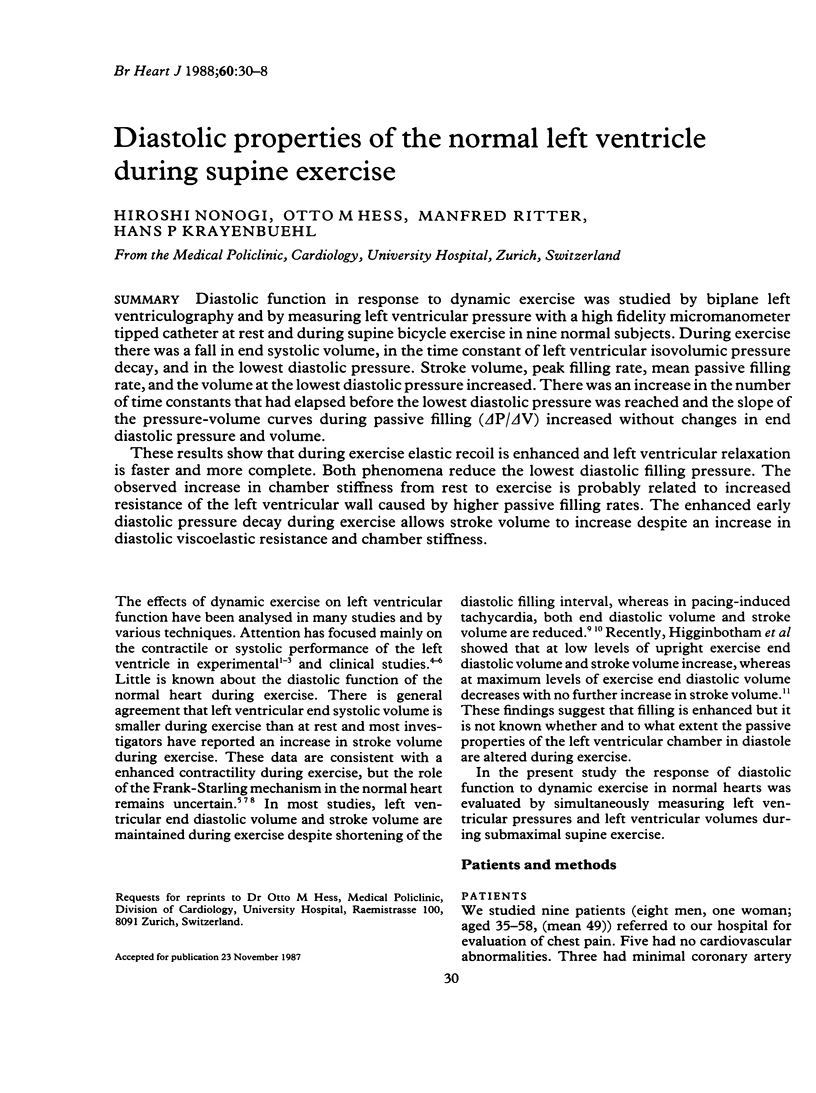
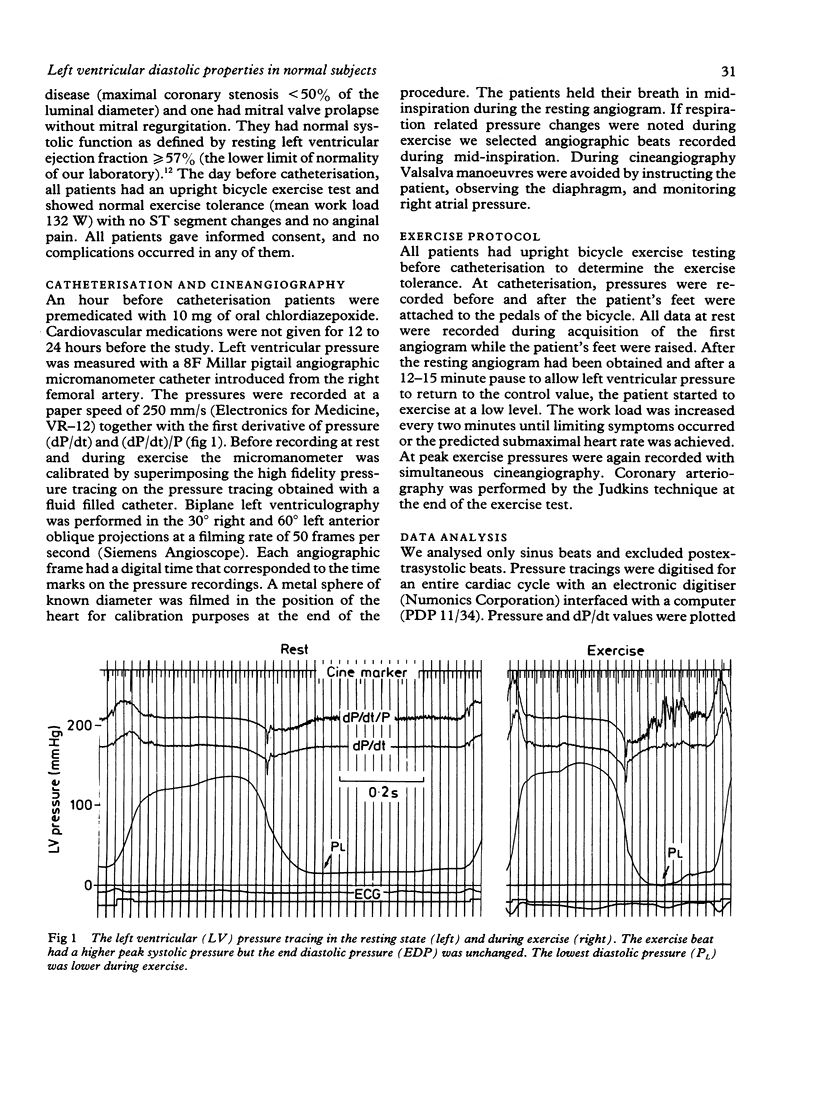
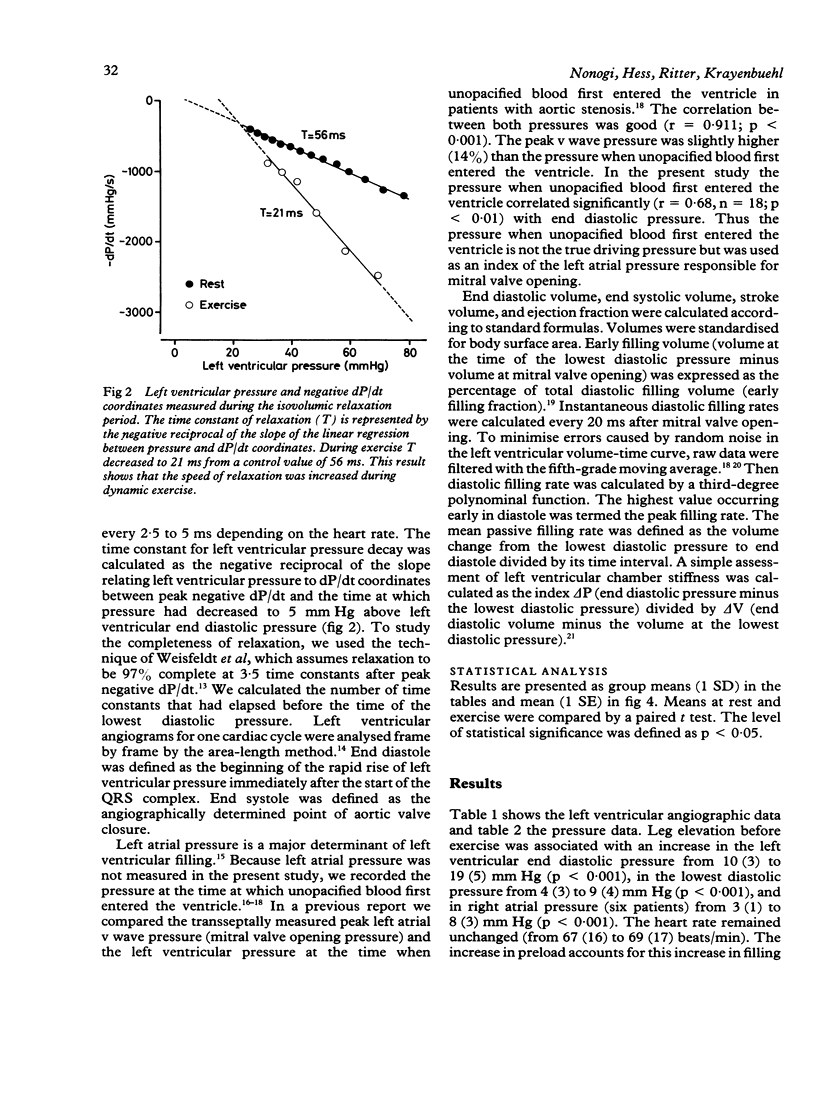
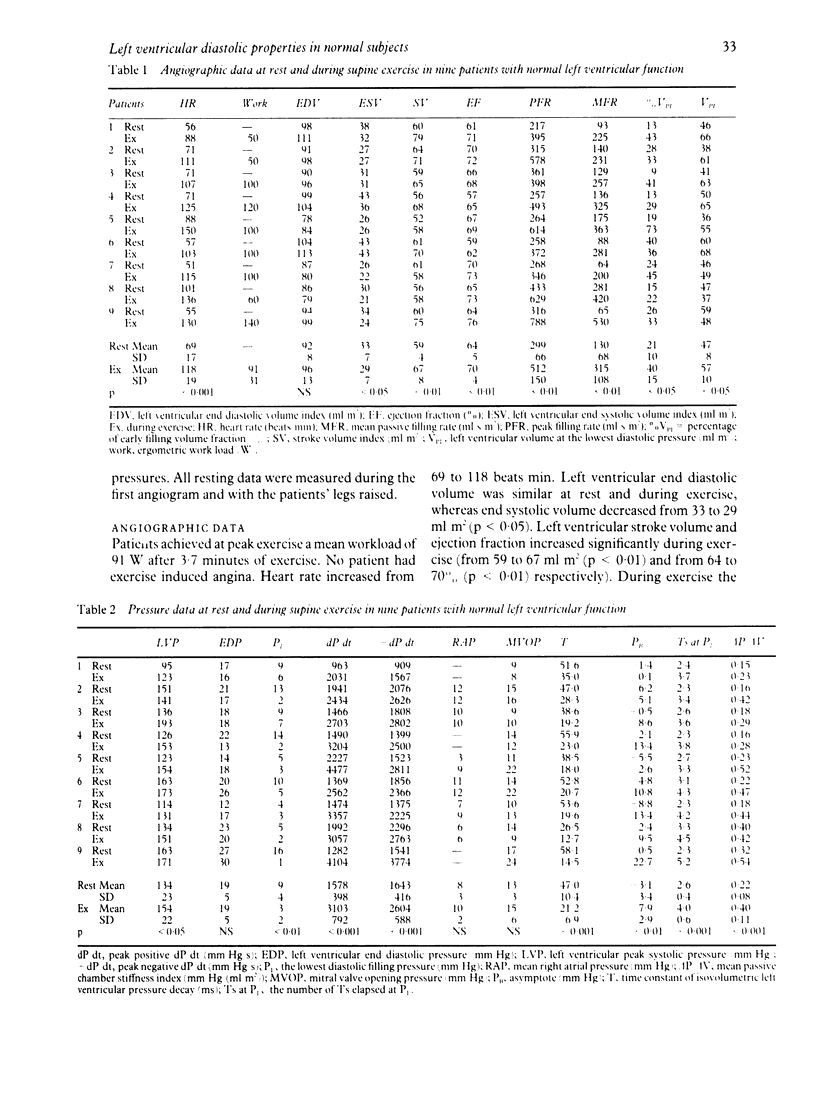
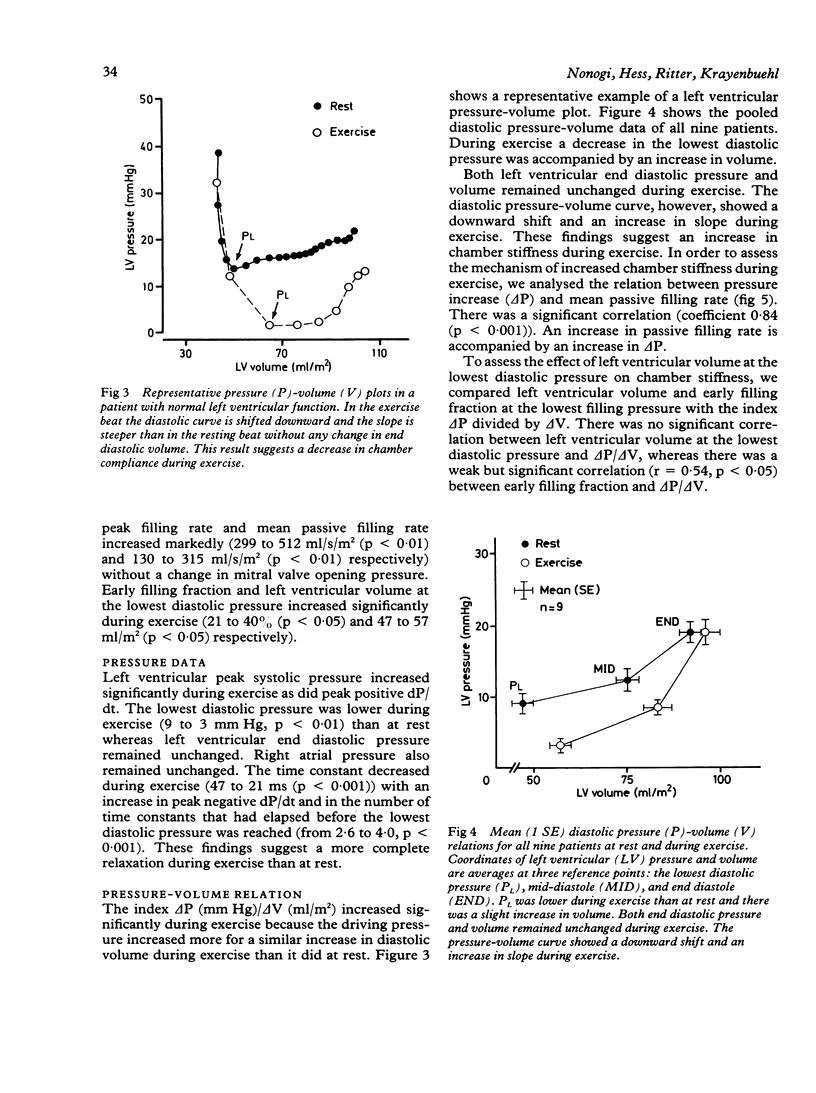
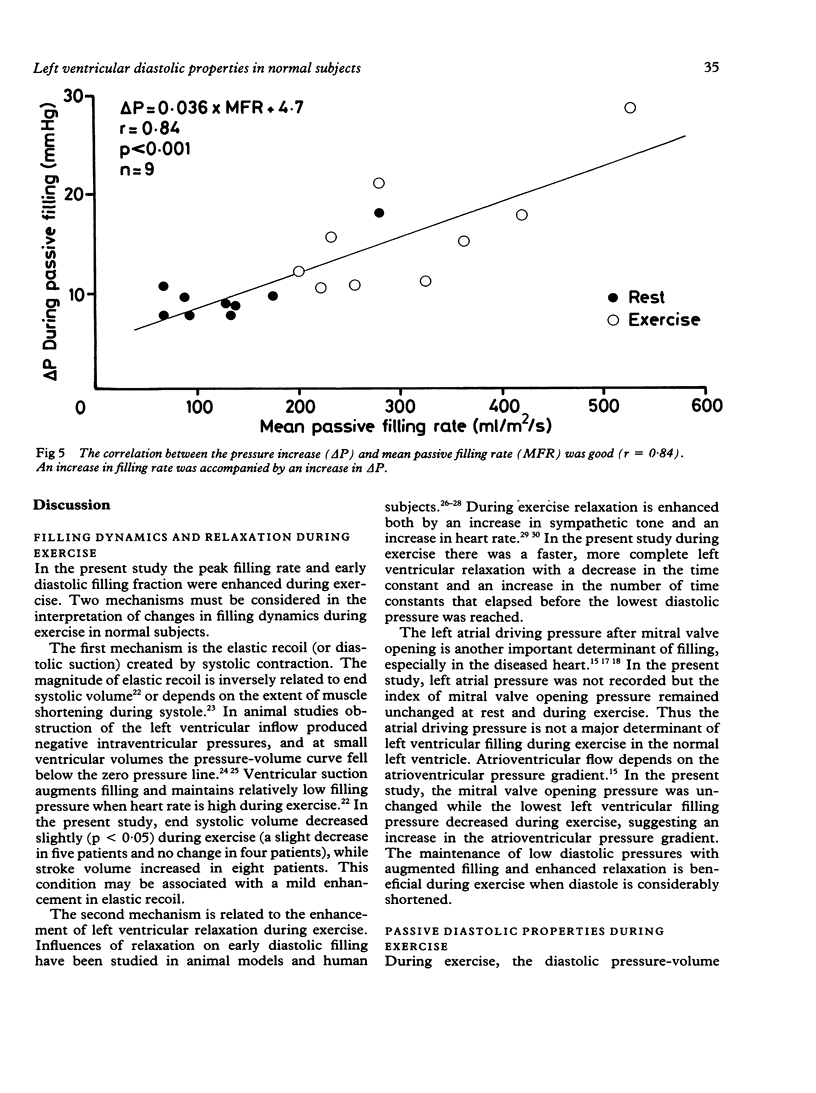
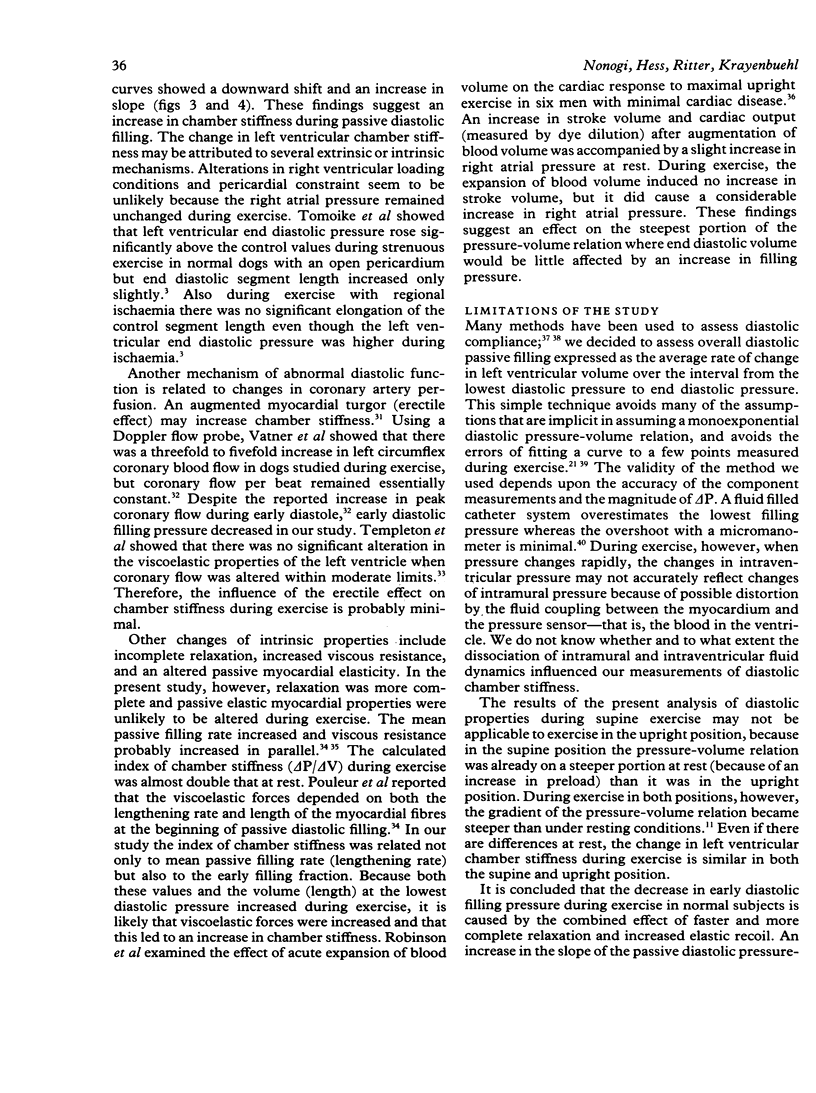
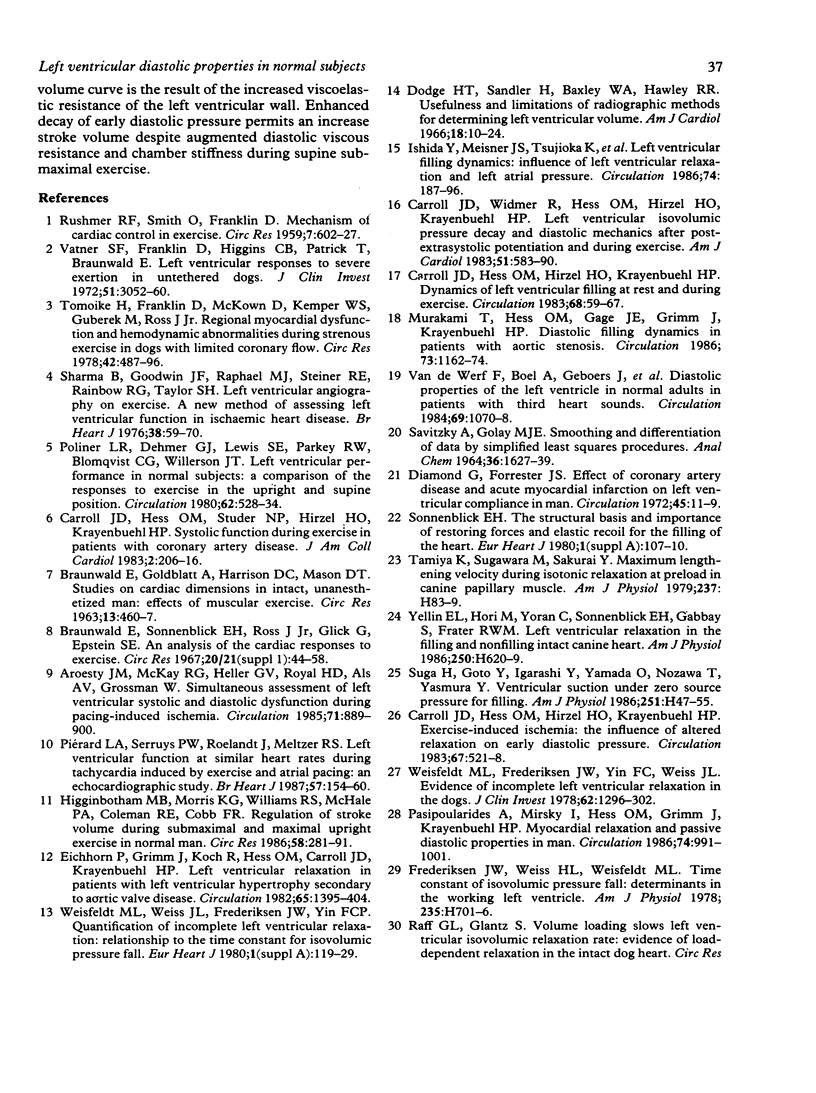
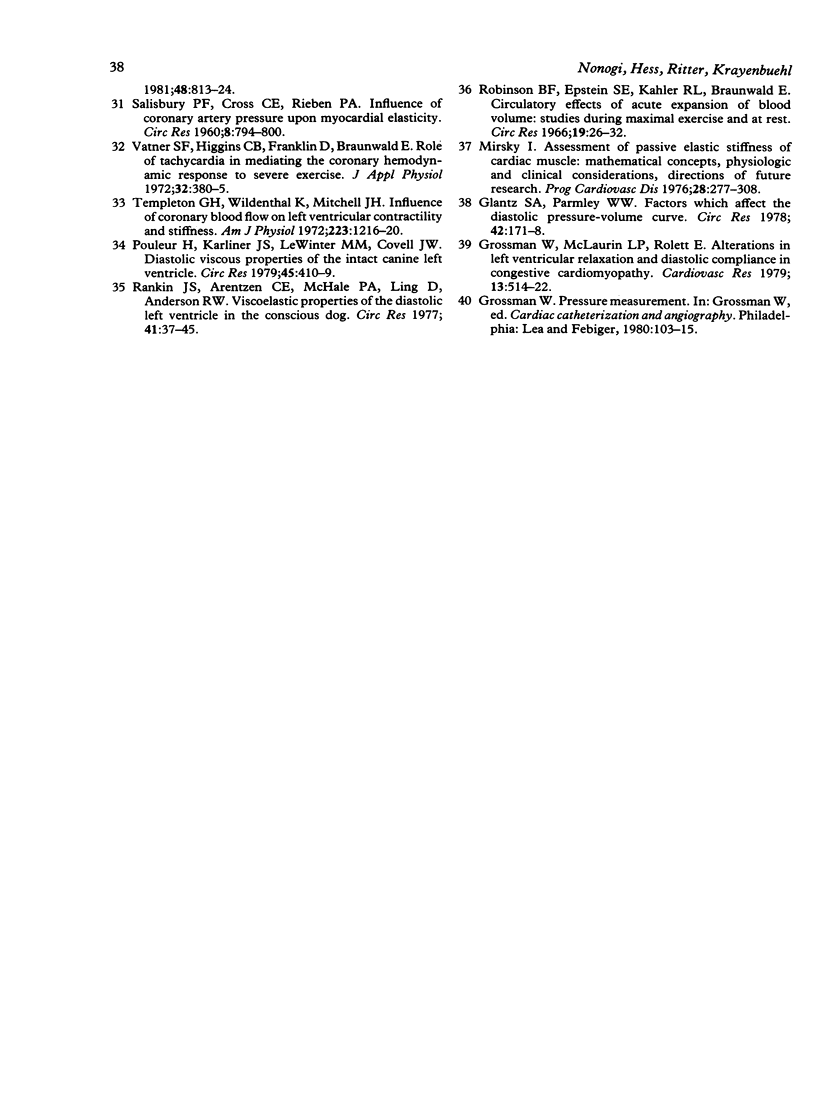
Selected References
These references are in PubMed. This may not be the complete list of references from this article.
- Aroesty J. M., McKay R. G., Heller G. V., Royal H. D., Als A. V., Grossman W. Simultaneous assessment of left ventricular systolic and diastolic dysfunction during pacing-induced ischemia. Circulation. 1985 May;71(5):889–900. doi: 10.1161/01.cir.71.5.889. [DOI] [PubMed] [Google Scholar]
- Carroll J. D., Hess O. M., Hirzel H. O., Krayenbuehl H. P. Dynamics of left ventricular filling at rest and during exercise. Circulation. 1983 Jul;68(1):59–67. doi: 10.1161/01.cir.68.1.59. [DOI] [PubMed] [Google Scholar]
- Carroll J. D., Hess O. M., Hirzel H. O., Krayenbuehl H. P. Exercise-induced ischemia: the influence of altered relaxation on early diastolic pressures. Circulation. 1983 Mar;67(3):521–528. doi: 10.1161/01.cir.67.3.521. [DOI] [PubMed] [Google Scholar]
- Carroll J. D., Hess O. M., Studer N. P., Hirzel H. O., Krayenbuehl H. P. Systolic function during exercise in patients with coronary artery disease. J Am Coll Cardiol. 1983 Aug;2(2):206–216. doi: 10.1016/s0735-1097(83)80155-7. [DOI] [PubMed] [Google Scholar]
- Carroll J. D., Widmer R., Hess O. M., Hirzel H. O., Krayenbuehl H. P. Left ventricular isovolumic pressure decay and diastolic mechanics after postextrasystolic potentiation and during exercise. Am J Cardiol. 1983 Feb;51(3):583–590. doi: 10.1016/s0002-9149(83)80101-5. [DOI] [PubMed] [Google Scholar]
- Diamond G., Forrester J. S. Effect of coronary artery disease and acute myocardial infarction on left ventricular compliance in man. Circulation. 1972 Jan;45(1):11–19. doi: 10.1161/01.cir.45.1.11. [DOI] [PubMed] [Google Scholar]
- Dodge H. T., Sandler H., Baxley W. A., Hawley R. R. Usefulness and limitations of radiographic methods for determining left ventricular volume. Am J Cardiol. 1966 Jul;18(1):10–24. doi: 10.1016/0002-9149(66)90191-3. [DOI] [PubMed] [Google Scholar]
- Eichhorn P., Grimm J., Koch R., Hess O., Carroll J., Krayenbuehl H. P. Left ventricular relaxation in patients with left ventricular hypertrophy secondary to aortic valve disease. Circulation. 1982 Jun;65(7):1395–1404. doi: 10.1161/01.cir.65.7.1395. [DOI] [PubMed] [Google Scholar]
- Frederiksen J. W., Weiss J. L., Weisfeldt M. L. Time constant of isovolumic pressure fall: determinants in the working left ventricle. Am J Physiol. 1978 Dec;235(6):H701–H706. doi: 10.1152/ajpheart.1978.235.6.H701. [DOI] [PubMed] [Google Scholar]
- Glantz S. A., Parmley W. W. Factors which affect the diastolic pressure-volume curve. Circ Res. 1978 Feb;42(2):171–180. doi: 10.1161/01.res.42.2.171. [DOI] [PubMed] [Google Scholar]
- Grossman W., McLaurin L. P., Rolett E. L. Alterations in left ventricular relaxation and diastolic compliance in congestive cardiomyopathy. Cardiovasc Res. 1979 Sep;13(9):514–522. doi: 10.1093/cvr/13.9.514. [DOI] [PubMed] [Google Scholar]
- Higginbotham M. B., Morris K. G., Williams R. S., McHale P. A., Coleman R. E., Cobb F. R. Regulation of stroke volume during submaximal and maximal upright exercise in normal man. Circ Res. 1986 Feb;58(2):281–291. doi: 10.1161/01.res.58.2.281. [DOI] [PubMed] [Google Scholar]
- Ishida Y., Meisner J. S., Tsujioka K., Gallo J. I., Yoran C., Frater R. W., Yellin E. L. Left ventricular filling dynamics: influence of left ventricular relaxation and left atrial pressure. Circulation. 1986 Jul;74(1):187–196. doi: 10.1161/01.cir.74.1.187. [DOI] [PubMed] [Google Scholar]
- Mirsky I. Assessment of passive elastic stiffness of cardiac muscle: mathematical concepts, physiologic and clinical considerations, directions of future research. Prog Cardiovasc Dis. 1976 Jan-Feb;18(4):277–308. doi: 10.1016/0033-0620(76)90023-2. [DOI] [PubMed] [Google Scholar]
- Murakami T., Hess O. M., Gage J. E., Grimm J., Krayenbuehl H. P. Diastolic filling dynamics in patients with aortic stenosis. Circulation. 1986 Jun;73(6):1162–1174. doi: 10.1161/01.cir.73.6.1162. [DOI] [PubMed] [Google Scholar]
- New developments in calcium antagonists. VIII European Congress of Cardiology Joint Symposium. 22-26 June, 1980, Paris, France. Eur Heart J. 1980 Dec;1(Suppl B):1–85. [PubMed] [Google Scholar]
- Pasipoularides A., Mirsky I., Hess O. M., Grimm J., Krayenbuehl H. P. Myocardial relaxation and passive diastolic properties in man. Circulation. 1986 Nov;74(5):991–1001. doi: 10.1161/01.cir.74.5.991. [DOI] [PubMed] [Google Scholar]
- Piérard L. A., Serruys P. W., Roelandt J., Meltzer R. S. Left ventricular function at similar heart rates during tachycardia induced by exercise and atrial pacing: an echocardiographic study. Br Heart J. 1987 Feb;57(2):154–160. doi: 10.1136/hrt.57.2.154. [DOI] [PMC free article] [PubMed] [Google Scholar]
- Poliner L. R., Dehmer G. J., Lewis S. E., Parkey R. W., Blomqvist C. G., Willerson J. T. Left ventricular performance in normal subjects: a comparison of the responses to exercise in the upright and supine positions. Circulation. 1980 Sep;62(3):528–534. doi: 10.1161/01.cir.62.3.528. [DOI] [PubMed] [Google Scholar]
- Pouleur H., Karliner J. S., LeWinter M. M., Covell J. W. Diastolic viscous properties of the intact canine left ventricle. Circ Res. 1979 Sep;45(3):410–419. doi: 10.1161/01.res.45.3.410. [DOI] [PubMed] [Google Scholar]
- RUSHMER R. F., SMITH O., FRANKLIN D. Mechanisms of cardiac control in exercise. Circ Res. 1959 Jul;7(4):602–627. doi: 10.1161/01.res.7.4.602. [DOI] [PubMed] [Google Scholar]
- Rankin J. S., Arentzen C. E., McHale P. A., Ling D., Anderson R. W. Viscoelastic properties of the diastolic left ventricle in the conscious dog. Circ Res. 1977 Jul;41(1):37–45. doi: 10.1161/01.res.41.1.37. [DOI] [PubMed] [Google Scholar]
- SALISBURY P. F., CROSS C. E., RIEBEN P. A. Influence of coronary artery pressure upon myocardial elasticity. Circ Res. 1960 Jul;8:794–800. doi: 10.1161/01.res.8.4.794. [DOI] [PubMed] [Google Scholar]
- Sharma B., Goodwin J. F., Raphael M. J., Steiner R. E., Rainbow R. G., Taylor S. H. Left ventricular angiography on exercise. A new method of assessing left ventricular function in ischaemic heart disease. Br Heart J. 1976 Jan;38(1):59–70. doi: 10.1136/hrt.38.1.59. [DOI] [PMC free article] [PubMed] [Google Scholar]
- Sonnenblick E. H. The structural basis and importance of restoring forces and elastic recoil for the filling of the heart. Eur Heart J. 1980;Suppl A:107–110. doi: 10.1093/eurheartj/1.suppl_1.107. [DOI] [PubMed] [Google Scholar]
- Suga H., Goto Y., Igarashi Y., Yamada O., Nozawa T., Yasumura Y. Ventricular suction under zero source pressure for filling. Am J Physiol. 1986 Jul;251(1 Pt 2):H47–H55. doi: 10.1152/ajpheart.1986.251.1.H47. [DOI] [PubMed] [Google Scholar]
- Tamiya K., Sugawara M., Sakurai Y. Maximum lengthening velocity during isotonic relaxation at preload in canine papillary muscle. Am J Physiol. 1979 Jul;237(1):H83–H89. doi: 10.1152/ajpheart.1979.237.1.H83. [DOI] [PubMed] [Google Scholar]
- Templeton G. H., Wildenthal K., Mitchell J. H. Influence of coronary blood flow on left ventricular contractility and stiffness. Am J Physiol. 1972 Nov;223(5):1216–1220. doi: 10.1152/ajplegacy.1972.223.5.1216. [DOI] [PubMed] [Google Scholar]
- Tomoike H., Franklin D., McKown D., Kemper W. S., Guberek M., Ross J., Jr Regional myocardial dysfunction and hemodynamic abnormalities during strenuous exercise in dogs with limited coronary flow. Circ Res. 1978 Apr;42(4):487–496. doi: 10.1161/01.res.42.4.487. [DOI] [PubMed] [Google Scholar]
- Van de Werf F., Boel A., Geboers J., Minten J., Willems J., De Geest H., Kesteloot H. Diastolic properties of the left ventricle in normal adults and in patients with third heart sounds. Circulation. 1984 Jun;69(6):1070–1078. doi: 10.1161/01.cir.69.6.1070. [DOI] [PubMed] [Google Scholar]
- Vatner S. F., Franklin D., Higgins C. B., Patrick T., Braunwald E. Left ventricular response to severe exertion in untethered dogs. J Clin Invest. 1972 Dec;51(12):3052–3060. doi: 10.1172/JCI107132. [DOI] [PMC free article] [PubMed] [Google Scholar]
- Vatner S. F., Higgins C. B., Franklin D., Braunwald E. Role of tachycardia in mediating the coronary hemodynamic response to severe exercise. J Appl Physiol. 1972 Mar;32(3):380–385. doi: 10.1152/jappl.1972.32.3.380. [DOI] [PubMed] [Google Scholar]
- Weisfeldt M. L., Frederiksen J. W., Yin F. C., Weiss J. L. Evidence of incomplete left ventricular relaxation in the dog: prediction from the time constant for isovolumic pressure fall. J Clin Invest. 1978 Dec;62(6):1296–1302. doi: 10.1172/JCI109250. [DOI] [PMC free article] [PubMed] [Google Scholar]
- Yellin E. L., Hori M., Yoran C., Sonnenblick E. H., Gabbay S., Frater R. W. Left ventricular relaxation in the filling and nonfilling intact canine heart. Am J Physiol. 1986 Apr;250(4 Pt 2):H620–H629. doi: 10.1152/ajpheart.1986.250.4.H620. [DOI] [PubMed] [Google Scholar]


